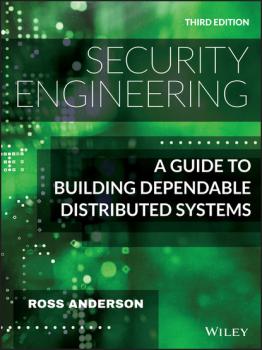John Wiley & Sons Limited
Все книги издательства John Wiley & Sons LimitedSecurity Engineering
Now that there’s software in everything, how can you make anything secure? Understand how to engineer dependable systems with this newly updated classic In Security Engineering: A Guide to Building Dependable Distributed Systems, Third Edition Cambridge University professor Ross Anderson updates his classic textbook and teaches readers how to design, implement, and test systems to withstand both error and attack. This book became a best-seller in 2001 and helped establish the discipline of security engineering. By the second edition in 2008, underground dark markets had let the bad guys specialize and scale up; attacks were increasingly on users rather than on technology. The book repeated its success by showing how security engineers can focus on usability. Now the third edition brings it up to date for 2020. As people now go online from phones more than laptops, most servers are in the cloud, online advertising drives the Internet and social networks have taken over much human interaction, many patterns of crime and abuse are the same, but the methods have evolved. Ross Anderson explores what security engineering means in 2020, including: How the basic elements of cryptography, protocols, and access control translate to the new world of phones, cloud services, social media and the Internet of Things Who the attackers are – from nation states and business competitors through criminal gangs to stalkers and playground bullies What they do – from phishing and carding through SIM swapping and software exploits to DDoS and fake news Security psychology, from privacy through ease-of-use to deception The economics of security and dependability – why companies build vulnerable systems and governments look the other way How dozens of industries went online – well or badly <l
Medical Statistics
The 5th edition of this popular introduction to statistics for the medical and health sciences has undergone a significant revision, with several new chapters added and examples refreshed throughout the book. Yet it retains its central philosophy to explain medical statistics with as little technical detail as possible, making it accessible to a wide audience. Helpful multi-choice exercises are included at the end of each chapter, with answers provided at the end of the book. Each analysis technique is carefully explained and the mathematics kept to minimum. Written in a style suitable for statisticians and clinicians alike, this edition features many real and original examples, taken from the authors' combined many years' experience of designing and analysing clinical trials and teaching statistics. Students of the health sciences, such as medicine, nursing, dentistry, physiotherapy, occupational therapy, and radiography should find the book useful, with examples relevant to their disciplines. The aim of training courses in medical statistics pertinent to these areas is not to turn the students into medical statisticians but rather to help them interpret the published scientific literature and appreciate how to design studies and analyse data arising from their own projects. However, the reader who is about to design their own study and collect, analyse and report on their own data will benefit from a clearly written book on the subject which provides practical guidance to such issues. The practical guidance provided by this book will be of use to professionals working in and/or managing clinical trials, in academic, public health, government and industry settings, particularly medical statisticians, clinicians, trial co-ordinators. Its practical approach will appeal to applied statisticians and biomedical researchers, in particular those in the biopharmaceutical industry, medical and public health organisations.









